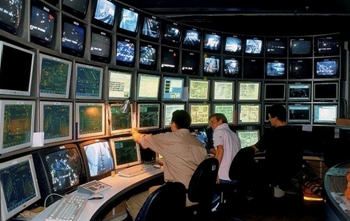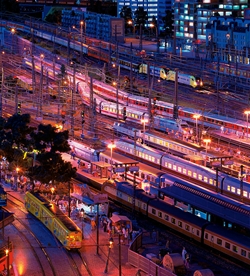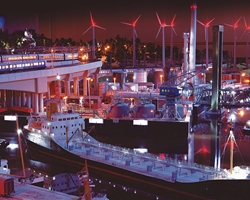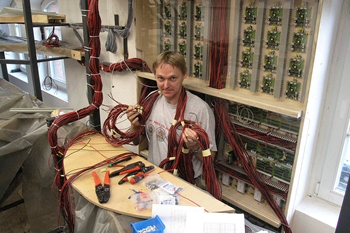Model railroad idea becomes German tourist ‘Wunder’

A control room worthy of a space mission, over 40 system computers, and hundreds of thousands of lines of custom
software code to make it operate – now that’s what I call a model train set!
In July of 2000 Frederik Braun and his girlfriend were visiting Zurich, Switzerland and found a model railroad shop
while exploring the area. An idea was born, and later that day he called his twin brother Gerrit and said, "We are
going to build the largest model railway in the world."
It wasn’t simple, easy, or cheap, but they accomplished that goal and turned it into a major German tourist
attraction. Over 6 miles of HO and HOE gauge track guide up to 800 trains through lifelike scenes spanning famous
places in Europe and the United States. The trains are really only a part of it though. All the modes of modern
transportation are modeled and mechanized with amazing detail and computerized operation.

(Click an image to open in greater detail)

Cars, trucks, and busses drive along smooth roadways under their own autonomous power. Each one has its own electric
motor with battery pack, and a microcontroller circuit board to manage navigation. The microcontroller runs a custom
on-board program that steers the vehicle along the roadway, and also communicates through a wireless signal to a
central computer, which coordinates traffic and destinations. The vehicles also have LED lighting, meticulously
installed by hand, to simulate a realistic appearance.
Motorized boats and ships travel through bodies of real water. Like the roadway vehicles, they also have their own
motor, power source, and microprocessor control system to take them along pre-programmed routes. Tiny solid-state
cameras display their journeys on monitor screens for both control engineers and visitors to observe.
Every 15 minutes a complete daytime/nighttime cycle is simulated. The nightscape is illuminated by over 300,000
LEDs, chosen for color to appear as real-world incandescent and high-intensity discharge lighting. The realistic
sequence is also controlled by one of the main system computers.
A major project, still being developed, is a full-scale airport with modern passenger jets arriving and
departing. This has been one of their most ambitious projects to date because of its scale.

Over 150 people are now employed to operate this attraction. Artists and model makers have painstakingly recreated
a miniature world in great detail. Programmers have written hundreds of thousands of lines of custom software code.
Computer engineers designed, built, and operate the extensive data acquisition and control system, which
incorporates over 40 main computers with the vehicle’s on-board microcontrollers. Technicians installed over 2,600
miles of wiring to connect it all, and maintenance workers keep it operational through a 7-day a week display
schedule.
Sebastian Drechsler is a native German that I got in contact with. He’s employed with the ‘Miniatur Wunderland’
attraction and was able to answer a few of my questions about this project.
Q. Did you originally plan this project for its current scale or did it expand over time?
We did not have something like a master plan when the project was started in 2000. These days our main goal is to
excite people from every gender and age. We did not expect this level of success. If we did not have the
possibility to enlarge the layout progressively, so many visitors would not come.
Q. How much of the mechanics and electronics did you have to design and build yourself?
Nearly 100%. Many mechanics in miniature scale are build for toys and do not fit for our standards. So we had to
build mechanics and electronics by ourselves, which can run 365 days a year, 11 hours on average.
Q. You’ve got motorized ships that travel through bodies of real water. What control mechanism guides these ships
along their routes?
We developed something like an auto-pilot for ships. We installed 48 handmade satellites and developed a control
program with more than 90,000 lines of code. But to be honest, this system is not working faultlessly. We have to
fix a few bugs. But these days our airport involves all of our engineers. So we hope to fix those after we opened
our airport in early 2011. Until then the ships are radio controlled.
Q. I was amazed at how realistic your nighttime simulation is. Were you able to do this with off-the-shelf hobby
products or did you have to experiment and develop your own LED lighting?
The light control is one of Gerrit’s masterpieces. He developed everything by himself. We produced our own
boards, microcontroller, and a software program which can control 300,000 LEDs individually to simulate something
like a realistic day and night cycle.
Q. Have you filled the space that you have available or will you still be expanding this project?
We have plans to expand until 2025 – at least. Therefore we rented 1,000 square meters more. We plan to build
Italy, France, England, India, Africa and hopefully many more countries. We have probably ideas for the next 100
years...
'Miniatur Wunderland' website

